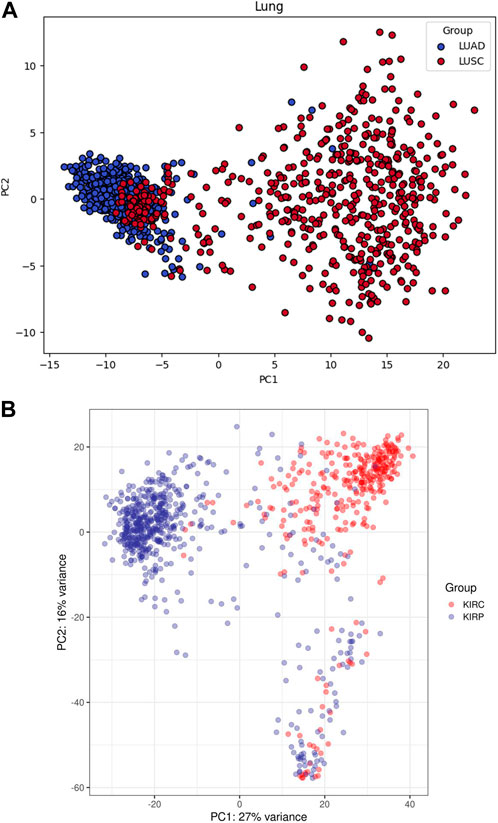- 1Division of Applied Mathematics, Brown University, Providence, RI, United States
- 2Department of Statistics, Giresun University, Giresun, Türkiye
- 3Department of Biostatistics, Erciyes University, Kayseri, Türkiye
- 4Vascular Research Laboratory, VA Providence Healthcare System, Providence, RI, United States
- 5Division of Cardiology, Department of Medicine, Alpert Medical School of Brown University, Providence, RI, United States
- 6Cardiovascular Research Center, Rhode Island Hospital, Providence, RI, United States
- 7Department of Biomedical and Pharmaceutical Sciences, University of Rhode Island College of Pharmacy, South Kingston, RI, United States
- 8School of Engineering, Brown University, Providence, RI, United States
Introduction: The advent of RNA sequencing (RNA-Seq) has significantly advanced our understanding of the transcriptomic landscape, revealing intricate gene expression patterns across biological states and conditions. However, the complexity and volume of RNA-Seq data pose challenges in identifying differentially expressed genes (DEGs), critical for understanding the molecular basis of diseases like cancer.
Methods: We introduce a novel Machine Learning-Enhanced Genomic Data Analysis Pipeline (ML-GAP) that incorporates autoencoders and innovative data augmentation strategies, notably the MixUp method, to overcome these challenges. By creating synthetic training examples through a linear combination of input pairs and their labels, MixUp significantly enhances the model’s ability to generalize from the training data to unseen examples.
Results: Our results demonstrate the ML-GAP’s superiority in accuracy, efficiency, and insights, particularly crediting the MixUp method for its substantial contribution to the pipeline’s effectiveness, advancing greatly genomic data analysis and setting a new standard in the field.
Discussion: This, in turn, suggests that ML-GAP has the potential to perform more accurate detection of DEGs but also offers new avenues for therapeutic intervention and research. By integrating explainable artificial intelligence (XAI) techniques, ML-GAP ensures a transparent and interpretable analysis, highlighting the significance of identified genetic markers.
1 Introduction
RNA sequencing (RNA-Seq) employs advanced sequencing technology to identify the nucleotide sequence of RNA molecules and measure the abundance of specific RNA types within RNA molecule populations (Deshpande et al., 2023). Typically, the main goal of RNA-Seq analysis is to detect genes that are expressed differently under various biological circumstances (Piao and Ryu, 2017). Traditional RNA-Seq analysis methodologies, while effective, often face limitations in identifying differentially expressed genes (DEGs) that are crucial for understanding the molecular underpinnings of diseases, including cancer. This challenge is magnified by the complexity and sheer volume of data generated, necessitating advanced analytical approaches to fully harness the potential of RNA-Seq data.
Recent research has established that the application of machine learning (ML) algorithms to RNA-Seq data can effectively classify different problems based on gene expression profiles. Dag et al. (Dag et al., 2023) introduced GeneSelectML, an open-source web-based tool for gene selection from RNA-Seq data using ML algorithms. It features 6 ML algorithms, pre-processing steps, and graphical outputs like heatmaps and network plots, alongside gene ontology analysis for DEGs. Demonstrated on Alzheimer’s RNA-seq data, GeneSelectML aids in identifying potential biomarkers by employing multiple ML algorithms simultaneously for gene selection. This tool combines pre-processing, visualization and ML methods. Stathopoulou et al. (Stathopoulou et al., 2024) investigated the overlap of ML algorithms in RNA-seq analysis for estimating gene expression across various cancer types. Using Random Forest and Gradient Boosting algorithms, their research demonstrated the reproducibility and overlap in identifying significant DEGs, enhancing the understanding of genes’ roles in cancer development. Their findings highlight the efficacy of combining ML with RNA-seq to improve the identification of critical DEGs, contributing valuable insights into cancer biology and potentially improving diagnostic and therapeutic strategies. Wang et al. (Wang et al., 2018) identified important features with three feature selection algorithms (Information Gain, Correlation Feature Selection, and ReliefF). They employed five widely used classifiers (Logistic Regression, Classification via Regression, Random Forest, Logistic Model Trees, Random Subspace) to predict DEGs. Their study demonstrates the applicability of ML to improve the prediction and understanding of gene expression, specifically in relation to transcriptional regulation in response to ethylene in plant seedlings. Piao and Ryu (Piao and Ryu, 2017) introduced a novel approach for identifying DEGs in RNA-seq data by applying a feature selection method that utilizes symmetrical uncertainty for gene ranking and a predefined relevance threshold for selection. In their evaluation, the method achieved high sensitivity (0.986) and specificity (0.982) on large-sample datasets, outperforming traditional statistical approaches like edgeR (Robinson et al., 2009), DESeq (Love et al., 2014), and baySeq (Hardcastle and Kelly, 2010) in terms of Area Under the Curve values, with notable improvements observed even in challenging small-sample conditions. Arowolo et al. (Arowolo et al., 2020) developed a principal component analysis (PCA) model to enhance RNA-seq malaria vector data classification using k-nearest neighbour (KNN) and Decision Tree algorithms. The team aimed to address the challenge of high dimensionality in malaria vector RNA-seq data by employing PCA for feature extraction. This method effectively reduced the dataset’s complexity, making it more manageable for classification tasks. The classification performance was evaluated on a mosquito Anopheles gambiae RNA-Seq dataset, yielding accuracy rates of 86.7% for KNN and 83.3% for Decision Tree classifiers.
While the application of ML to RNA-Seq data shows promise, there are concerns regarding the interpretability of the models. According to Rudin (Rudin, 2019), black box ML models may not be suitable for high-stakes decisions in the context of medical research. Instead, Rudin suggests the use of interpretable models to ensure transparency and understanding of the underlying mechanisms (Rudin, 2019). This insight raises important considerations for the development and application of ML models in the context of RNA-Seq data analysis. The present study introduces a novel Machine Learning-Enhanced Genomic Analysis Pipeline (ML-GAP) utilizing autoencoders and data augmentation, aimed at addressing these challenges. By integrating ML techniques with autoencoders and data augmentation strategies, ML-GAP provides a new approach to enhance the detection of DEGs, particularly those elusive to conventional methods. Our pipeline not only facilitates a more in-depth analysis of RNA-Seq data but also aids in the identification of potential genes associated with clinical outcomes, thereby offering new avenues for medical research. The incorporation of explainable artificial intelligence (XAI) techniques distinguishes ML-GAP, enabling a transparent and interpretable analysis that underscores the significance of identified genetic markers. ML-GAP stands as a testament to the power of ML in genomic data analysis, setting a new standard for accuracy, efficiency, and insights in the field.
The paper is organized as follows. In Section 2, the materials and methods used in the study are presented, covering the comprehensive workflow of ML-GAP for RNA-Seq data. In Section 3, we present the findings from applying the ML-GAP to RNA-Seq data, highlighting the performance of our approach in identifying DEGs and showcasing the effectiveness of the MixUp method in improving model generalization. Additionally, the full forms of the abbreviations are listed in Supplementary Table S1.
2 Material and methods
2.1 Overview of the study
This study introduces ML-GAP, an approach specifically designed to address the challenges inherent in RNA-Seq data analysis. It leverages advanced ML techniques, including autoencoders and data augmentation strategies such as MixUp, to enhance the detection of DEGs. These methods not only improve the accuracy of gene expression analysis but also offer robustness against the noise and variability typical of RNA-Seq data. The pipeline is further refined by the incorporation of XAI techniques, ensuring that the analytical process remains transparent and the results interpretable. We constructed this pipeline using Python as the main programming language, integrating several libraries such as Scikit-learn for machine learning, SHAP and LIME for explainability, and other tools for genomic data preprocessing and analysis.
1. Count Data The initial step involves compiling a data matrix, denoted as
2. Data Preprocessing
a. Filtering: Applying both low count filtering and zero-variance filter to refine the count data.
b.Normalization: Employing DESeq median normalization to adjust the data.
c.Transformation: Implementing variance stabilizing transformation to make the data more suitable for analysis.
3. Dimension Reduction
a. Principal Component Analysis (PCA): PCA is employed to reduce the gene count in the genetic or molecular profiles dataset to 2000. This step significantly simplifies the complexity of the data, making it more manageable for subsequent analysis and improving interpretability.
b.Dimension Reduction for Differentially Expressed Genes (DEGs): Following PCA, the gene count is further reduced to 200 features using differential expression analysis. This focused reduction selects genes that show statistically significant differences in expression associated with clinical outcomes, thus enhancing the potential for meaningful biological insights and therapeutic targets.
4. Machine Learning Performance After applying the dimensionality reduction techniques, we evaluated the performance of machine learning models using three distinct approaches: PCA and DEGs, Autoencoders, and Augmentation with MixUp. For each approach, we calculated several performance metrics, including Accuracy, Positive Predictive Value (PPV), Negative Predictive Value (NPV), Sensitivity, Specificity, and F1 Score. These metrics provide a comprehensive evaluation of the models’ effectiveness in identifying DEGs across our datasets. We optimized the model parameters using a 5-fold cross-validation grid search. To evaluate the model performance, we used an independent test set, splitting the dataset into training and testing sets with an 80/20 ratio using the train_test_split function from Scikit-learn.
a. PCA and DEGs Approach: Dimensionality was first reduced via PCA and DEGs selection. Machine learning models were then applied to this refined dataset, and the performance was assessed based on the aforementioned metrics.
b.Autoencoders Approach: Following dimensionality reduction via autoencoders, models were trained and evaluated similarly using the same set of metrics.
c.Augmentation Approach (MixUp): The dataset was augmented using the MixUp technique before applying the machine learning models, which were evaluated using the same metrics to assess the impact of augmentation on model performance.
5. Explainable Machine Learning (XAI)
a. SHAP (SHapley Additive exPlanations) SHAP is employed to determine the influence of each gene on the model’s output, thereby enhancing the interpretability of the model’s decisions. It identifies the top-10 features based on the performance evaluation.
b.LIME (Local Interpretable Model-agnostic Explanations) LIME elucidates model predictions by approximating the model locally with an interpretable surrogate, which helps in understanding the impact of various features on the model’s decisions. Top-10 features are identified following the analysis of model performance.
c. Variable Importance (VarImp) This technique highlights the genes that significantly influence predictions, underlining their biological importance. VarImp is used to determine top-10 features after applying ML models and evaluating their performance.
6. Biological Validation
a. Graphical Representations Visual representations are created such as Volcano plots and Ven diagrams.
b.Gene Ontology The functionality of selected genes is compared with existing literature to validate their roles and relevance in biological processes and disease mechanisms.
2.2 Dataset and preprocesisng
We conducted an analysis utilizing two RNA-Seq datasets pertaining to Renal Cell Carcinoma (RCC), sourced from The Cancer Genome Atlas (TCGA) network.
2.2.1 Renal cell carcinoma (RCC)
From TCGA, we obtained sequencing reads for 20,531 recognized human RNAs from a cohort of 1,020 patients diagnosed with RCC. These patients were classified into three predominant subtypes: kidney renal papillary cell carcinoma (KIRP), kidney renal clear cell carcinoma (KIRC), and kidney chromophobe carcinoma (KICH), with respective sample counts of 606, 323, and 91. In the RCC dataset, we excluded data labeled as KICH, maintaining only the records for KIRC and KIRP patients, culminating in a final tally of 929 observations.
2.2.2 Lung cancer data
We utilized data on lung cancer obtained from the TCGA platform. This dataset includes the mapped read counts for 20,531 recognized human RNAs from 1,128 patients with lung cancer. These patients were classified into two specific lung cancer types: lung adenocarcinoma (LUAD) and lung squamous cell carcinoma (LUSC), with respective sample sizes of 576 and 552.
Principal components plots for lung and RCC data, shown in Figure 1, illustrate the separation of samples based on the first two principal components. These plots highlight the inherent variance within the datasets and the effectiveness of the preprocessing steps. The dimensionality reduction achieved through PCA is crucial for subsequent analyses, as it highlights the distinct clustering of the different cancer subtypes, thereby confirming the integrity and quality of our dataset.
2.2.3 Data preprocessing
RNA-Seq data inherently presents an abundance of zero values and encompasses variations between samples stemming from experimental procedures. The preprocessing steps outlined in Figure 2 are employed to mitigate the impact of low-quality features and inter-sample variations. Initially, features with exceedingly low counts were excluded through near-zero variance filtering (Kuhn, 2008). Subsequently, a normalization process was executed on the pre-filtered raw counts before progressing to downstream analyses. This step aimed to mitigate the influence of sequencing depth, technical variation, and potential biases, while retaining the inherent biological variations among samples. To achieve this, we implemented the median-ratio normalization method from the DESeq2 package (Love et al., 2014), chosen for its resilience against outliers and its efficacy in eliminating technical variations across samples. We calculated the size factor
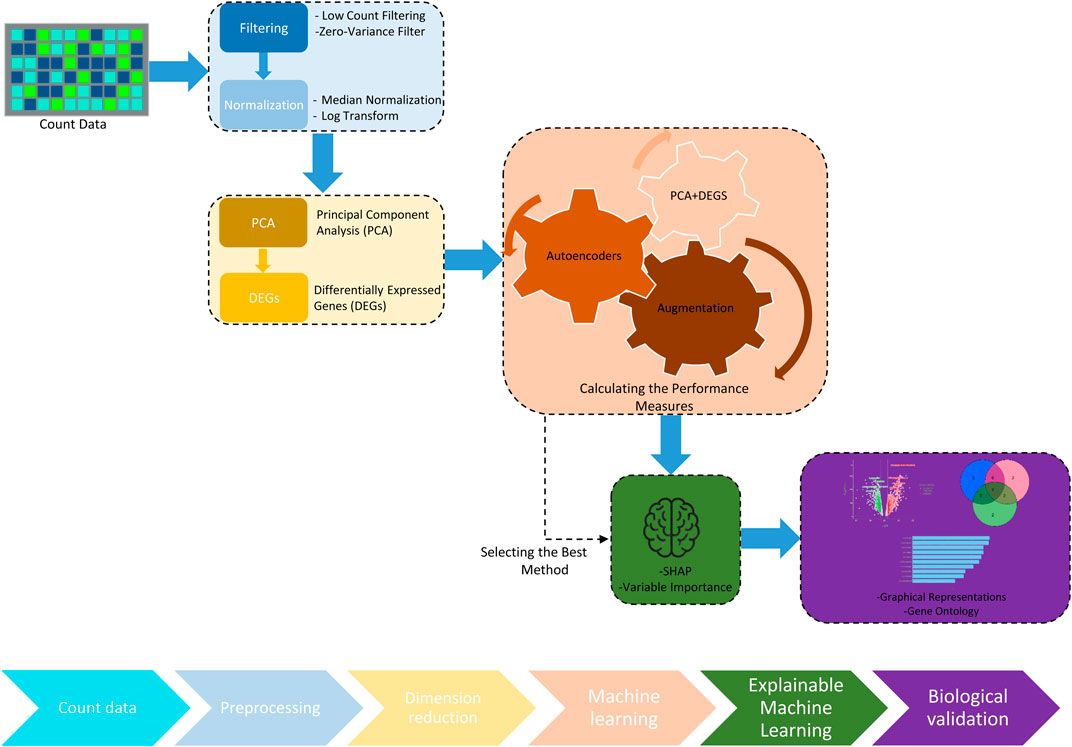
Figure 2. Workflow of the data processing and the pipeline in the proposed methodology. The workflow utilized for processing and analyzing transcriptomics data. Starting with raw count data, the process involves preprocessing steps such as filtering and normalization, followed by dimension reduction through principal component analysis (PCA). The analysis identifies differentially expressed genes (DEGs), which are then processed through ML techniques, including PCA and DEGs and Autoencoders, to measure and enhance algorithm performance. The pipeline integrates data augmentation techniques to improve model robustness and employs explainable artificial intelligence (XAI) tools like SHAP to interpret the model outcomes. The workflow concludes with molecular biology validation to confirm the biological relevance of the findings.
where
In the preprocessing step, we transfer the data from raw counts to normalized counts. Given that RNA-Seq data contains many features and few observations
2.3 Dimension reduction
2.3.1 Principal component analysis (PCA)
Principal Component Analysis (PCA) is a statistical technique used in data analysis and ML to emphasize variation and extract strong patterns, with its modern version formalized by Hotelling (Hotelling, 1933). It simplifies complex genetic information by transforming it into a lower-dimensional space, revealing key variables (principal components). By highlighting significant relationships in high-dimensional data, PCA aids in visualizing and analyzing genetic patterns and biological processes. This study employs PCA after normalizing RNA-Seq data to reduce its dimensionality.
2.3.2 Differentially Expressed Genes (DEGs)
The identification of differentially expressed genes (DEGs) is crucial in bioinformatics to detect genes with statistically significant differences in expression levels across various sample groups. After applying PCA for dimensionality reduction, further analysis focuses on identifying DEGs to gain insights into genetic expression changes linked to clinical outcomes. This dual approach ensures that features selected for ML models are highly informative, both statistically and biologically, thereby reducing complexity while highlighting potential therapeutic targets.
2.4 Machine learning model performance
2.4.1 Autoencoders
Autoencoders, first introduced by McClelland et al. (1987), are a type of neural network used in unsupervised learning, designed to recreate their input. Their primary function is to learn useful features or representations within the data. An autoencoder typically consists of three key components: an encoder, a compressed representation (also known as the bottleneck or latent layer), and a decoder as seen in Figure 3. The encoder condenses the data into a reduced-dimensional space, and the decoder restores the data to its original shape. In our study, we employed an autoencoder neural network structure to explore dimensionality reduction within our dataset, which was split into training and test sets. The input layer of the autoencoder consisted of 200 neurons, corresponding to the dimensionality of the data in the training set. This was followed by an encoder layer with 128 neurons and a hidden layer with 72 neurons, representing the compressed representation of the input data. The decoder part of the network then aimed to reconstruct the input data from this reduced 72-neuron representation. By training the autoencoder on the training set and evaluating its performance on the test set, we were able to assess the model’s ability to reduce the dimensionality of the data from 200 to 72 while still retaining the essential characteristics necessary for reconstruction. The observations in the test set that resulted in the lowest reconstruction error, particularly the 72 with the most minimal error, were identified as those best represented by the autoencoder, demonstrating the model’s effectiveness in dimensionality reduction.

Figure 3. Detailed schematic of an autoencoder network for RNA sequencing data compression and reconstruction. The ‘Encoder’ stage (g(x)) processes the input high-dimensional RNAseq data, compressing it into a condensed representation at the ‘Bottleneck Layer’ (z). Subsequently, the ‘Decoder’ stage (f(z)) aims to reconstruct the RNAseq data from this lower-dimensional representation to an output (x’) that is as similar to the original input as possible. This process enables the reduction of data complexity and noise, facilitating more efficient storage and analysis.
2.4.2 Augmentation (MixUp)
Zhang et al. (Zhang et al., 2017) introduced an advanced data augmentation technique, called MixUp, devised to address the issue of class imbalance by generating new samples through a strategic combination of data points. This technique is grounded on the Equation 2:
where
2.4.3 Machine learning model performance
In the analysis of RCC and lung cancer data, both Random Forest and XGBoost ML algorithms were utilized to develop predictive models. To optimize the performance of these models, a comprehensive grid search was conducted to fine-tune their hyperparameters. This involved the use of repeated k-fold cross-validation, specifically partitioning the data into five folds, to ensure a robust evaluation of the model’s performance across various subsets of the data. The grid search method, executed with a 5-fold cross-validation approach, is crucial for verifying the generalizability and efficacy of the ML models on unseen data, thereby ensuring that the selected models are well-suited for predicting outcomes in RCC and lung cancer cases based on their respective optimized parameters. We explain different algorithm steps in the following workflow as represented in Figure 2.
(a) PCA and DEGs: Initially, the dimensionality of the dataset was reduced using PCA and the identification of DEGs. This step was crucial for simplifying the dataset by focusing on the most informative features.
(b) Autoencoders Approach: Following the initial dimensionality reduction, autoencoders were utilized as an advanced technique to further compress the dataset into a more manageable size. This was particularly beneficial for capturing complex, nonlinear relationships within the data. ML models were then applied to this refined dataset, and their performance metrics were evaluated.
(c) Augmentation Approach: To augment the dataset post-initial dimensionality reduction (PCA and DEGs), an augmentation technique, specifically MixUp, was implemented. This approach not only reduced dimensionality but also increased the number of samples by blending observations. Subsequently, ML models were applied to this enhanced dataset, and their efficacy was assessed through various performance metrics.
2.5 Explainable Machine Learning (XAI)
Upon determining the most effective dimensionality reduction method—be it PCA and DEGs, Autoencoders, or Augmentation approaches, based on accuracy metrics—we proceeded to apply XAI techniques to elucidate the predictive models further. Specifically, we utilized SHAP, LIME, and VarImp analyses and selected the top-10 important features. These techniques were instrumental in identifying the most significant features contributing to the models’ predictions, thereby enhancing the transparency and interpretability of our ML models. This step is critical for understanding the underlying mechanisms of the models’ decisions, particularly in the complex domain of RCC and lung cancer prediction, where interpretability is as crucial as accuracy.
2.6 Biological Validation
2.6.1 Graphical representations
Following the identification of effective features through the application of XAI techniques, we visually represented these selected features using Volcano plots and Venn diagrams. Volcano plots were employed to depict the statistical significance versus the magnitude of change of the features, offering a clear visualization of the most influential features identified by our models. Similarly, Venn diagrams were utilized to illustrate the overlap and uniqueness of significant features across different models or dimensionality reduction techniques.
2.6.2 Gene ontology (GO)
In our analysis pipeline, we incorporated a Gene Ontology (GO) step to ascertain whether the selected features are relevant to lung cancer or RCC. This bioinformatics approach enables us to categorize the identified genes based on the related biological processes, cellular components, and molecular functions. By mapping the significant features to GO terms, we were able to validate the biological significance of these features in the context of lung cancer and RCC. This step is crucial for ensuring that the ML models are not only statistically robust but also biologically relevant, thereby enhancing the credibility and applicability of our findings in clinical settings. In this step, we checked the selected features that are related to the literature on lung cancer and listed the results listed in Table 2.
3 Results and discussion
In our study, as delineated in Figure 2, we initiated our data preprocessing by applying a “Filtering” step to the lung cancer and RCC count data. This filtering aimed at excluding features with low variability, specifically targeting those with negligible variance—often referred to as ‘near-zero variance’. This preliminary refinement was critical to ensure the integrity of our dataset, thereby preventing potential biases in the analysis due to superfluous or non-informative data. Subsequent to the filtering, we proceeded with the normalization of the data in the “Normalization” step. For this purpose, we employed a median-ratio normalization method, which is a part of the DESeq2 bioinformatics tool. This particular normalization technique is known for its effectiveness in reducing technical biases without distorting the genuine biological differences between the samples. By employing this approach, we were able to achieve a normalized dataset that reliably reflects the underlying biological conditions. In the subsequent phase of our analysis, following the filtering and normalization steps, we employed “PCA” step as a dimensionality reduction technique. PCA is a robust statistical method that converts the data into a series of linearly independent variables called principal components. This technique enables us to reduce the complexity of our data by transitioning from a high-dimensional space—comprising approximately 19,000 variables—to a more manageable, lower-dimensional space. By doing so, PCA accentuates the most significant patterns and relationships within the data, which are essential for our further analysis. The dimension reduction accomplished through PCA is instrumental in enhancing computational efficiency and improving the interpretability of the dataset, thus preparing the ground for the subsequent identification of DEGs. Subsequent to dimensionality reduction through PCA, where we effectively condensed our dataset’s features from around 2000 to 200 features, we embarked on the critical phase of identifying DEGs in “DEGs” step. DEGs are genes that show statistically significant differences in expression levels between different biological states or experimental conditions. In our analysis, the reduced dimensionality facilitated a more targeted and efficient investigation into gene expression changes. By applying statistical tests to the principal components, we were able to detect genes whose expression levels were consistently altered across our sample groups. This identification of DEGs is a pivotal step in our research, as it lays the groundwork for understanding the molecular mechanisms that may underlie the biological phenomena under study. The DEGs serve as valuable markers for potential pathways that are activated or suppressed in response to specific conditions, providing insights that are essential for further biological interpretation and validation. After the filtering and dimension reduction steps, we compare the proposed methods with classic PCA and DEGs dimension reduction techniques in the Machine Learning Solution step. In this step, we compare three different methods as seen below.
1. Machine learning algorithms, including XGBoost and Random Forest, were applied to a dataset of 200 genes that had been refined through PCA and DEGs identification methods. The effectiveness of these algorithms was evaluated using various performance metrics.
2. Autoencoders were then employed to further reduce the dimensionality of the dataset, which resulted from PCA and DEGs methods, down to 72 features. Subsequently, the XGBoost and Random Forest algorithms were applied to this reduced dataset, and performance metrics were calculated to assess the impact of this dimensionality reduction.
3. The dataset of 200 genes, derived from PCA and DEGs methods, was augmented using the MixUp technique, which artificially expands the data pool without additional dimensionality reduction. This augmentation is intended to enhance the robustness and generalizability of the ML models. After augmentation, the same ML algorithms were re-applied, and the resulting performance metrics were examined to determine the effectiveness of this augmentation.
As detailed in Table 1, the MixUp technique, when applied to the RCC dataset, emerged as the most effective strategy across various metrics, particularly when used with the XGBoost model. This method achieved outstanding performance, with perfect scores for NPV (1.0000) and Recall (Sensitivity) (1.0000), indicating its accuracy in correctly identifying both true negatives and true positives. Additionally, MixUp delivered impressive results in terms of Accuracy (0.9946), Precision (PPV: 0.9915), and the F1 Score (0.9957), which highlights the balance between Precision and Recall.
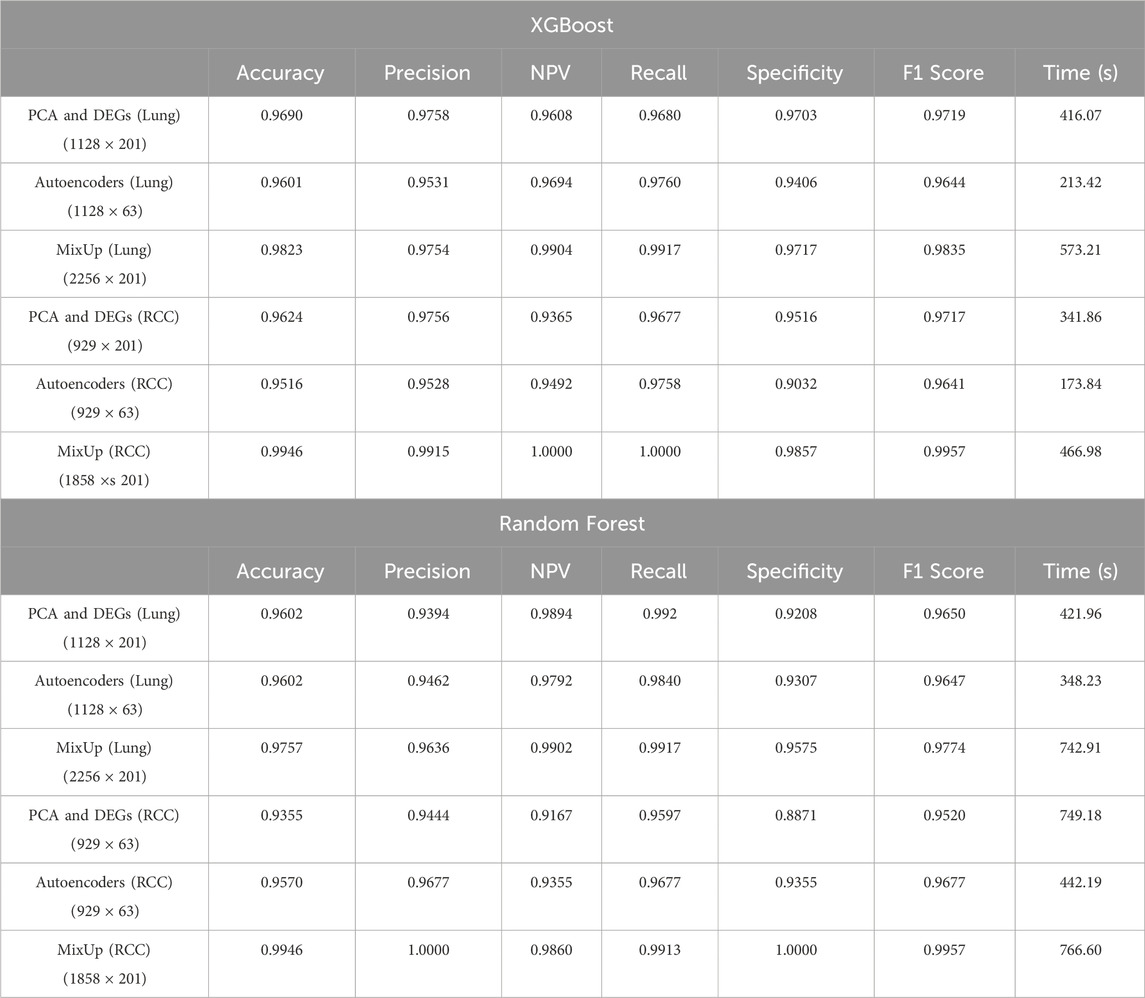
Table 1. Comparative analysis of model evaluation metrics for XGBoost and Random Forest across different datasets: RCC and lung datasets. The performance metrics are shown for different data processing techniques including PCA & DEGs, Autoencoders, and MixUp augmentation.
Although the computational time for MixUp was higher due to the increased dataset size from synthetic data generation (as reflected in Table 1), the significant improvements in predictive performance more than justify this added cost. Particularly in cases where achieving a balance between Precision and Recall is critical, MixUp proved to enhance model robustness and overall classification performance. The technique’s superior results in handling imbalanced data, especially in the RCC dataset, underscore its potential to improve model reliability across various performance metrics.
Given the superior results yielded by the MixUp method, we proceeded to identify the most impactful features affecting our RNA-Seq data within this framework in “XAI” step. To accomplish this, we calculated VarImp using the Random Forest and XGBoost algorithms applied to both lung and RCC datasets. We further enriched our analysis by implementing SHAP and LIME methodologies to ascertain the top-10 most essential genes in our model’s performance. The selected genes were not only prominent based on variable importance rankings but also stood out in SHAP and LIME analyses, confirming their significant role in the predictive model. We have listed the top-10 features obtained from the XGBoost and Random Forest models—namely SHAP, LIME, and VarImp—in Figure 4.
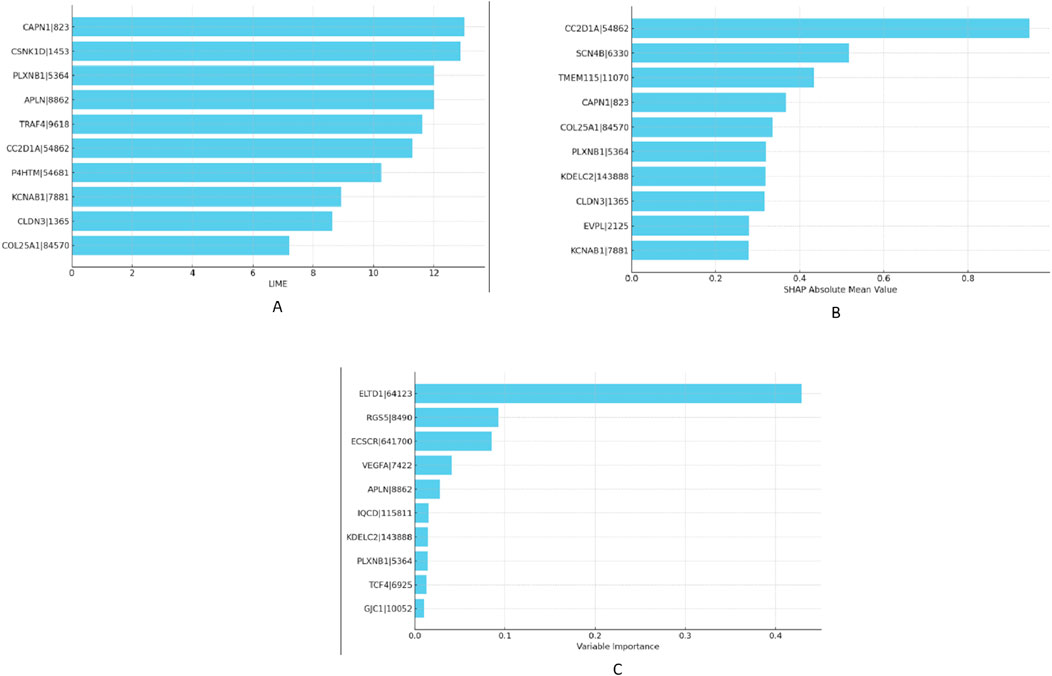
Figure 4. Comparative visualization of feature importances as determined by XGBoost for RCC dataset: (A) LIME scores, (B) SHAP values, and (C) variable importance metrics.
In the “Biological Validation”, we utilize Volcano plots to graphically illustrate the significant gene expressions identified during the XAI analysis. Figures 5, 6 in showcase these pivotal findings for RCC and lung cancer data respectively. The plots incorporate algorithms such as random forest and XGBoost in conjunction with interpretability methods like LIME, SHAP, and Variable Importance. Each plot is methodically constructed with the x-axis representing the log fold change (logFC) and the y-axis depicting the negative logarithm of the p-value (-log10 p-value). This arrangement accurately measures the degree of changes in gene expression and their statistical importance. As expected, none of the top genes identified as influential features are located within the gray zone of these plots, which signifies non-significant gene expression. This absence of features in the gray zone underscores the distinct and substantial impact that these genes have in relation to kidney and lung cancer, as determined by the advanced feature selection techniques employed in our study.
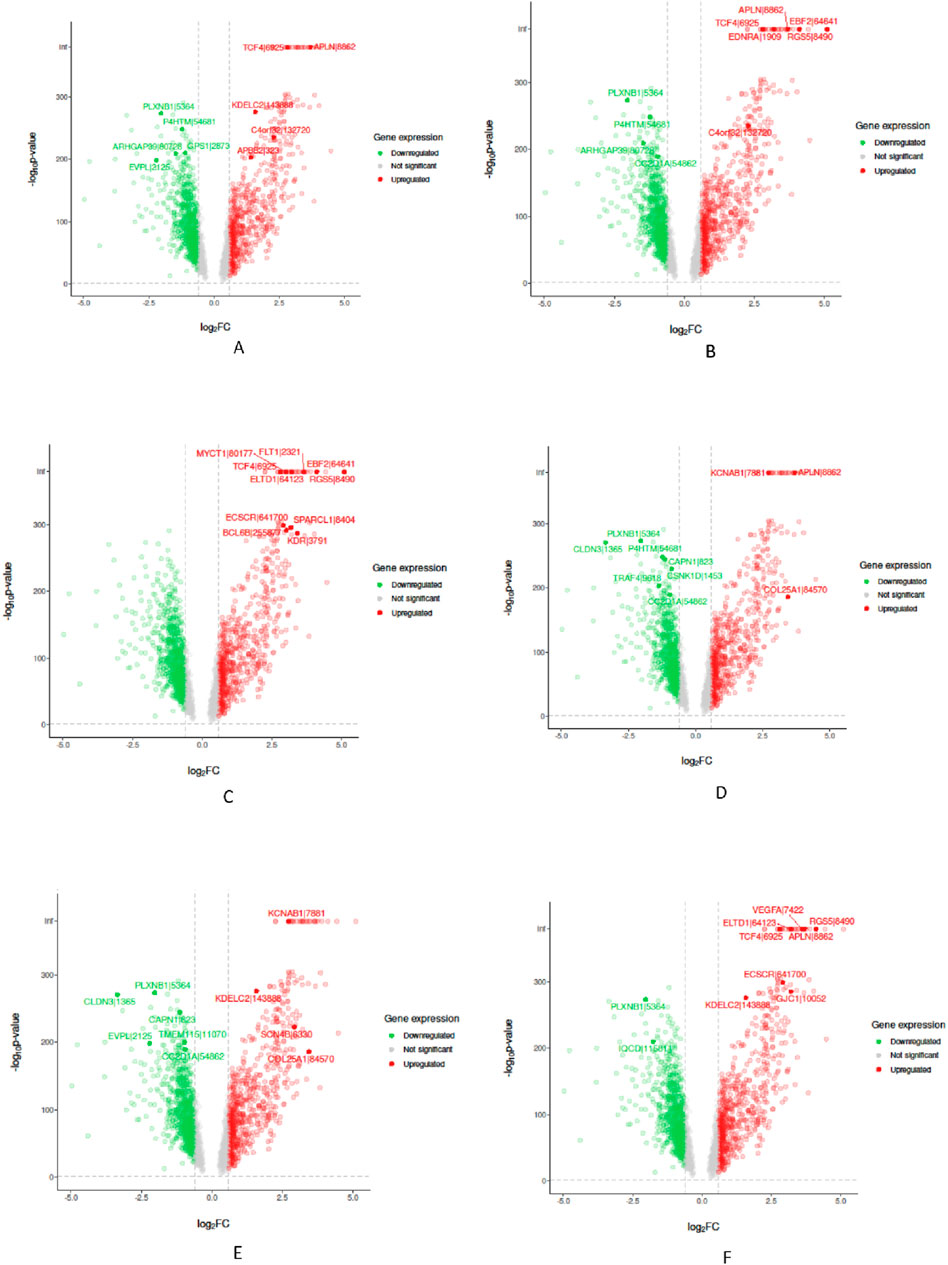
Figure 5. Volcano plots for Random Forest (RF) and eXtreme Gradient Boosting (XGB) models displaying selected feature importance in RCC data. Each plot utilizes a different interpretability method, namely LIME, SHAP, and Variable Importance (VarImp), to highlight the most influential features. The x-axis shows the log fold change (logFC), indicating the magnitude of change in gene expression, while the y-axis represents the negative logarithm of the p-value (−log10 p-value), denoting statistical significance. The plots differentiate between significant (red), non-significant (green), and unregulated (gray) gene expressions. (A) RF LIME - Random Forest model feature importance using LIME explanation method. (B) RF SHAP - Random Forest model feature importance using SHAP values for explanation. (C) RF VarImp - Random Forest model feature importance using Variable Importance. (D) XGB LIME - eXtreme Gradient Boosting model feature importance using LIME explanation. (E) XGB SHAP - eXtreme Gradient Boosting model feature importance using SHAP values for explanation. (F) XGB VarImp - eXtreme Gradient Boosting model feature importance using Variable Importance.
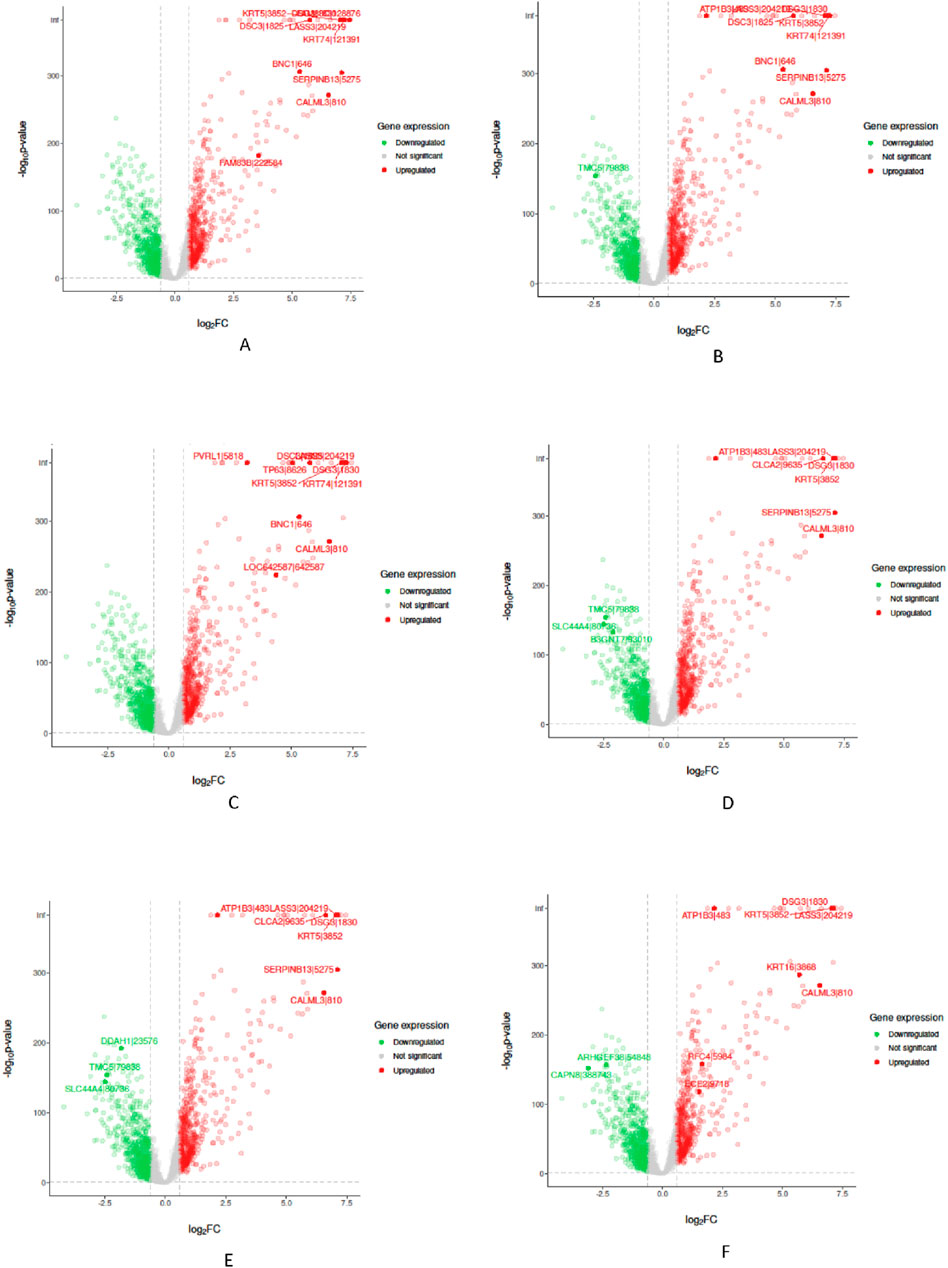
Figure 6. Volcano plots for Random Forest (RF) and eXtreme Gradient Boosting (XGB) models displaying selected feature importance in lung data. Each plot utilizes a different interpretability method, namely LIME, SHAP, and Variable Importance (VarImp), to highlight the most influential features. The x-axis shows the log fold change (logFC), indicating the magnitude of change in gene expression, while the y-axis represents the negative logarithm of the p-value (−log10 p-value), denoting statistical significance. The plots differentiate between significant (red), non-significant (green), and unregulated (gray) gene expressions. (A) RF LIME - Random Forest model feature importance using LIME explanation method. (B) RF SHAP - Random Forest model feature importance using SHAP values for explanation. (C) RF VarImp - Random Forest model feature importance using Variable Importance. (D) XGB LIME - eXtreme Gradient Boosting model feature importance using LIME explanation. (E) XGB SHAP - eXtreme Gradient Boosting model feature importance using SHAP values for explanation. (F) XGB VarImp - eXtreme Gradient Boosting model feature importance using Variable Importance.
Additionally, we selected the top 10 important features and listed those selected by at least two algorithms in Figure 7. The Venn diagrams presented in Figure 7 offer a visual comparison of the interpretability methods applied to the Random Forest (RF) and XGBoost (XGB) models across Lung and RCC datasets. These diagrams illustrate the features selected by at least two methods, namely, SHAP, LIME, and VarImp. For the RF Lung model (a), we see that eight features were identified by at least two methods as important, suggesting a strong consensus on these features’ influence on the model’s predictions: BNC1, CALML3, DSC3, DSG3, KRT5, LRT74, LASS3, and SERPINB13. In the case of the XGB Lung model (b), nine features were identified by all three methods as important, suggesting a strong consensus on these features’ influence on the model’s predictions: ATP1B3, CALML3, CLCA2, DSG3, KRT5, LASS3, SERPINB13, SLC44A4, and TMC5. For the RF RCC model (c), at least two methods selected APLN, ARHGAP39, C4orf32, P4HTM, PLXNB1, TCF4, EBF2, and RGS5. Lastly, the XGB RCC model (d) shows a notable distribution with eight features, CAPN1, CC2D1A, CLDN3, COL25A1, KCNAB1, PLXNB1, KDELC2, and APLN, identified by VarImp, SHAP, and LIME.
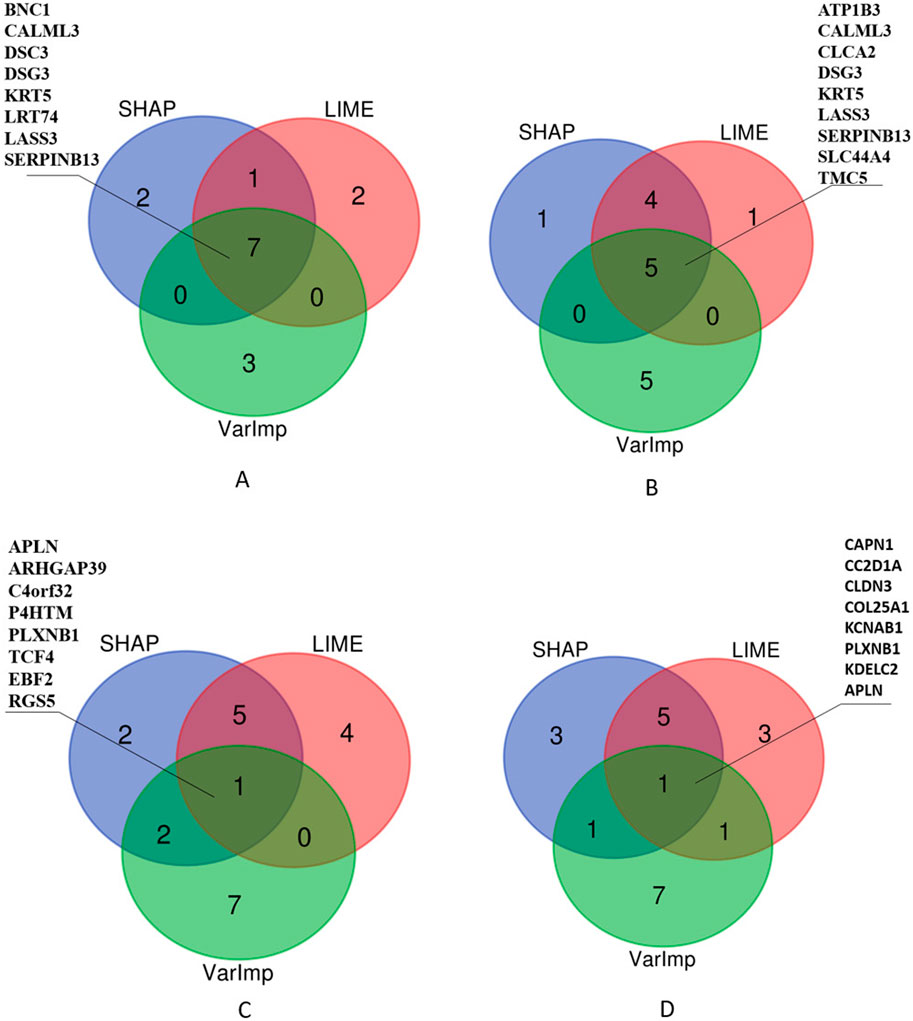
Figure 7. Comparison of XAI methods across different models and datasets. The Venn diagrams illustrate the overlap and uniqueness of selected features as determined by SHAP (SHapley Additive exPlanations), LIME (Local Interpretable Modelagnostic Explanations), and Variable Importance (VarImp) for Random Forest (RF) and eXtreme Gradient Boosting (XGB) models on Lung and RCC datasets. Each number within the diagrams represents the count of features identified by the corresponding methods.
As illustrated in Table 1, given that both methods exhibited performances that were roughly equivalent to each other, we investigated the efficacy of the genes located at the intersection of these two methods, as depicted in Figure 7, by analyzing their effectiveness in accordance with studies in the literature, as will be seen in Table 2.
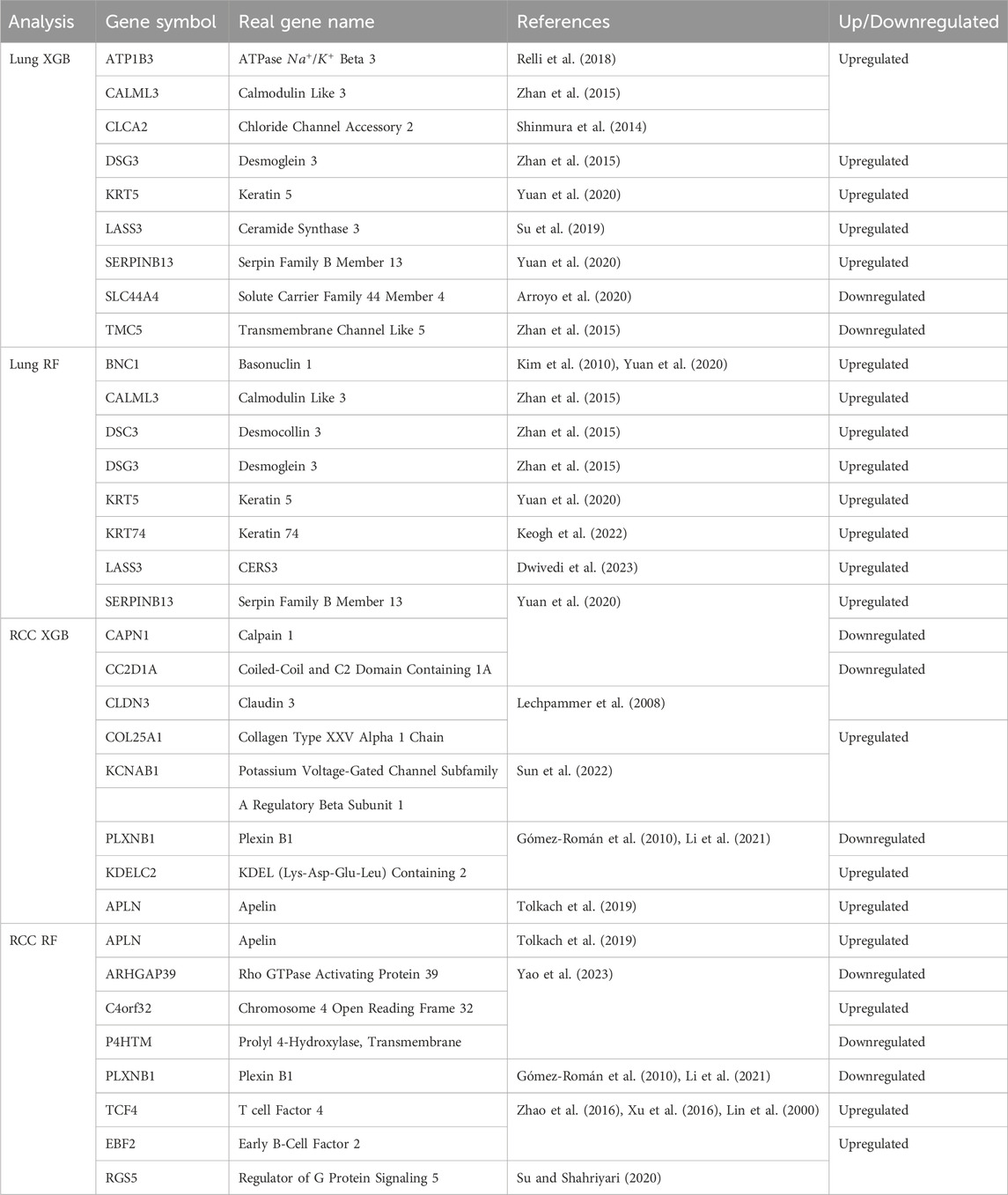
Table 2. Differential Gene Expression in Lung and Renal Cell Carcinoma Tissue. The table outlines the regulation patterns of specific genes in lung (Lung XGB, Lung RF) and renal cell carcinoma (RCC XGB, RCC RF) tissues. Gene symbols, their full names, and references for the associated studies are provided alongside the regulation status. Genes are selected by at least two methods: SHAP, LIME, and VarImp.
In Table 2, we present a summarized overview of gene regulation patterns discernible in lung tissue and RCC, which are listed among the intersected genes in Figure 7. This table is pivotal for delineating the differential expression of genes, as it systematically catalogs those that are upregulated and, notably, the singular gene that is downregulated in the context of RCC. Our analysis employed two distinct methodologies, denoted as XGB and RF, to analyze gene expression patterns across lung and RCC tissues. The ‘Up/Downregulated’ column indicates whether a gene is expressed at higher (upregulated) or lower (downregulated) levels than a predetermined baseline, which in this context is the normal tissue expression level. For lung tissue, the uniform upregulation across both analytical methods (XGB and RF) highlights a consistent over-expression of genes like ATP1B3, which encodes the beta-3 subunit of the
Feature selection in RNA-Seq studies is typically performed using well-established modeling techniques available in R/BIOCONDUCTOR packages like DESeq2 and edgeR. However, these methods are not specifically designed to identify features that contribute most effectively to classification models. Some features, despite being differentially expressed between comparison groups, may not significantly improve the predictive power of a fitted model. To address this, we proposed a hybrid feature selection methodology that aims to select features that are both differentially expressed and contribute meaningfully to the classification model’s performance.
While our methodology is robust, its effectiveness may be influenced by factors such as sample size, feature count, and overdispersion in the data. A comprehensive simulation study, particularly one focusing on Type-I and Type-II error rates, would be valuable for further evaluating these factors. However, this falls beyond the current scope of our study and could be explored in future research. The limitations mentioned have been acknowledged within the manuscript.
4 Conclusion
This study introduced a ML-GAP that utilizes autoencoders and data augmentation to enhance the detection and interpretation of DEGs from RNA-Seq count data. The overarching goal was to address the limitations of traditional RNA-Seq analysis methods by incorporating advanced ML techniques, thereby providing a deeper understanding of gene expression patterns and their associations with clinical outcomes. The ML-GAP workflow includes several key steps: data preprocessing to mitigate low-quality features and inter-sample variations; dimensionality reduction through PCA and DEGs identification; and data augmentation to increase the robustness and generalizability of the ML models. Notably, the MixUp augmentation method demonstrated superior results, especially in the context of RCC, indicating its effectiveness in enhancing the predictive accuracy of our models. Therefore, we further analyzed the results obtained from the MixUp method in the next step XAI. The application of XAI techniques, such as SHAP and LIME, has been crucial in ensuring the transparency and interpretability of our findings. These methods allowed us to identify the most impactful features, aligning with our objective to not only predict but also understand the biological significance behind the predictions. The integration of GO analysis further validated the relevance of these features in the context of lung cancer and RCC, underscoring the biological and clinical implications of our results.
The ML-GAP represents a significant advance in genomic analysis, combining the strengths of ML, data augmentation, and interpretability to uncover novel insights into gene expression dynamics. However, challenges such as data quality, computational demands, and the need for further methodological refinement remain. Future work will focus on addressing these challenges, exploring additional datasets, and continuing to enhance the pipeline’s accuracy and applicability to various genomic contexts. Additionally, in future work, it will be valuable to explore the use of generative deep learning models for generating realistic bulk RNA-Seq gene expression data. Similar to Wang et al.‘s study (Wang et al., 2024), which used Generative Adversarial Networks (GANs) to produce augmented datasets and analyzed them with SHAP, integrating these models into our ML-GAP pipeline could significantly enhance data augmentation and improve downstream analyses in high-throughput transcriptomics.
Data availability statement
Publicly available datasets were analyzed in this study. This data can be found here: https://www.cancer.gov/ccg/research/genome-sequencing/tcga.
Ethics statement
The studies involving humans were approved by The Cancer Genome Atlas (TCGA). The studies were conducted in accordance with the local legislation and institutional requirements. The participants provided their written informed consent to participate in this study.
Author contributions
MA: Conceptualization, Data curation, Formal Analysis, Investigation, Methodology, Project administration, Resources, Software, Validation, Visualization, Writing–original draft, Writing–review and editing. DG: Data curation, Formal Analysis, Investigation, Validation, Visualization, Writing–original draft, Writing–review and editing, Software. PZ: Conceptualization, Funding acquisition, Investigation, Writing–review and editing. B-RC: Writing–review and editing, Validation. RC: Investigation, Methodology, Validation, Writing–review and editing. GC: Conceptualization, Formal Analysis, Funding acquisition, Investigation, Methodology, Validation, Writing–review and editing. GK: Conceptualization, Funding acquisition, Methodology, Supervision, Writing–review and editing.
Funding
The author(s) declare that financial support was received for the research, authorship, and/or publication of this article. This work was supported in part by facilities and resources at the VA Providence Healthcare System, the Cardiopulmonary Vascular Biology (CPVB) COBRE core facilities (P20GM103652) and P30GM149398. The views expressed in this article are those of the authors and do not necessarily reflect the position or policy of the Department of Veterans Affairs or the U.S. government.
Conflict of interest
The authors declare that the research was conducted in the absence of any commercial or financial relationships that could be construed as a potential conflict of interest.
Publisher’s note
All claims expressed in this article are solely those of the authors and do not necessarily represent those of their affiliated organizations, or those of the publisher, the editors and the reviewers. Any product that may be evaluated in this article, or claim that may be made by its manufacturer, is not guaranteed or endorsed by the publisher.
Supplementary material
The Supplementary Material for this article can be found online at: https://www.frontiersin.org/articles/10.3389/fgene.2024.1442759/full#supplementary-material
Abbreviations
DEGs, Differentially Expressed Genes; LIME , Local Interpretable Model-agnostic Explanations; LUAD, Lung Adenocarcinoma; LUSC, Lung Squamous Cell Carcinoma; ML, Machine Learning; ML-GAP, Machine Learning-Enhanced Genomic Data Analysis Pipeline; PCA, Principal Component Analysis; RCC, Renal Cell Carcinoma; RNA-Seq, RNA Sequencing; SHAP, SHapley Additive exPlanations; TCGA, The Cancer Genome Atlas; VarImp, Variable Importance; XAI, explainable artificial intelligence.
References
Anders, S., and Huber, W. (2010). Differential expression analysis for sequence count data. Genome Biol. 11, R106. doi:10.1186/gb-2010-11-10-r106
Arowolo, M. O., Adebiyi, M., Adebiyi, A., and Okesola, O. (2020). “Pca model for rna-seq malaria vector data classification using knn and decision tree algorithm,” in 2020 international conference in mathematics, computer engineering and computer science (ICMCECS) (IEEE), 1–8.
Arroyo, M., Larrosa, R., Gómez-Maldonado, J., Cobo, M., Claros, M., and Bautista, R. (2020). Expression-based, consistent biomarkers for prognosis and diagnosis in lung cancer. Clin. Transl. Oncol. 22, 1867–1874. doi:10.1007/s12094-020-02328-4
Bullard, J. H., Purdom, E., Hansen, K. D., and Dudoit, S. (2010). Evaluation of statistical methods for normalization and differential expression in mrna-seq experiments. BMC Bioinforma. 11, 94. doi:10.1186/1471-2105-11-94
Dag, O., Kasikci, M., Ilk, O., and Yesiltepe, M. (2023). Geneselectml: a comprehensive way of gene selection for rna-seq data via machine learning algorithms. Med. and Biol. Eng. and Comput. 61, 229–241. doi:10.1007/s11517-022-02695-w
Deshpande, D., Muszyńska, A., Zhao, F., P Łabaj, P., Mangul, S., Zhang, J., et al. (2023). Rna-seq data science: from raw data to effective interpretation. Front. Genet. 14, 997383. doi:10.3389/fgene.2023.997383
Dwivedi, K., Rajpal, A., Rajpal, S., Agarwal, M., Kumar, V., and Kumar, N. (2023). An explainable ai-driven biomarker discovery framework for non-small cell lung cancer classification. Comput. Biol. Med. 153, 106544. doi:10.1016/j.compbiomed.2023.106544
Gómez-Román, J. J., Nicolas Martınez, M., Lazuén Fernández, S., and Val-Bernal, J. F. (2010). Plxnb1 (plexin b1). Atlas Genet. Cytogenet Oncol. Haematol. 3, 416–422. doi:10.4267/2042/44702
Hardcastle, T. J., and Kelly, K. A. (2010). baySeq: empirical bayesian methods for identifying differential expression in sequence count data. BMC Bioinforma. 11, 422. doi:10.1186/1471-2105-11-422
Hotelling, H. (1933). Analysis of a complex of statistical variables into principal components. J. Educ. Psychol. 24, 498–520. doi:10.1037/h0070888
Keogh, A., Ryan, L., Nur, M. M., Baird, A.-M., Nicholson, S., Cuffe, S., et al. (2022). Uso1 expression is dysregulated in non-small cell lung cancer. Transl. Lung Cancer Res. 11, 1877–1895. doi:10.21037/tlcr-22-230
Kim, E., Park, A., Dong, S., Ahn, J., and Park, W. (2010). Global analysis of cpg methylation reveals epigenetic control of the radiosensitivity in lung cancer cell lines. Oncogene 29, 4725–4731. doi:10.1038/onc.2010.223
Kuhn, M. (2008). Building predictive models in r using the caret package. J. Stat. Softw. 28. doi:10.18637/.jss.v028.i05
Lechpammer, M., Resnick, M. B., Sabo, E., Yakirevich, E., Greaves, W. O., Sciandra, K. T., et al. (2008). The diagnostic and prognostic utility of claudin expression in renal cell neoplasms. Mod. Pathol. 21, 1320–1329. doi:10.1038/modpathol.2008.116
Li, C.-X., Long, D., and Meng, Q. (2021). Promising therapeutic targets in kidney renal clear cell carcinoma: plxna1 and plxnb3. Cancer Biotherapy and Radiopharm. 39, 276–290. doi:10.1089/cbr.2021.0336
Lin, G., Zang, T., Zhang, Z., Xing, D., and Guo, Y. (2000). Expression of t cell factor 4 in renal cell carcinoma. Zhonghua wai ke za zhi Chin. J. Surg. 38, 460–461.
Love, M. I., Huber, W., and Anders, S. (2014). Moderated estimation of fold change and dispersion for RNA-seq data with DESeq2. Genome Biol. 15, 550. doi:10.1186/s13059-014-0550-8
McClelland, J. L., Rumelhart, D. E., PDP Research Group, , Asanuma, C., Crick, F. H. C., Elman, J. L., et al. (1987) “Parallel distributed processing,” in Explorations in the microstructure of cognition: psychological and biological models, 2. MIT Press.
Mortazavi, A., Williams, B. A., McCue, K., Schaeffer, L., and Wold, B. (2008). Mapping and quantifying mammalian transcriptomes by rna-seq. Nat. Methods 5, 621–628. doi:10.1038/nmeth.1226
Piao, Y., and Ryu, K. H. (2017). “Detection of differentially expressed genes using feature selection approach from rna-seq,” in 2017 IEEE international conference on big data and smart computing (BigComp) (IEEE), 304–308.
Relli, V., Trerotola, M., Guerra, E., and Alberti, S. (2018). Distinct lung cancer subtypes associate to distinct drivers of tumor progression. Oncotarget 9, 35528–35540. doi:10.18632/oncotarget.26217
Robinson, M. D., McCarthy, D. J., and Smyth, G. K. (2009). edgeR: a Bioconductor package for differential expression analysis of digital gene expression data. Bioinformatics 26, 139–140. doi:10.1093/bioinformatics/btp616
Robinson, M. D., and Oshlack, A. (2010). A scaling normalization method for differential expression analysis of rna-seq data. Genome Biol. 11, R25. doi:10.1186/gb-2010-11-3-r25
Rudin, C. (2019). Stop explaining black box machine learning models for high stakes decisions and use interpretable models instead. Nat. Mach. Intell. 1, 206–215. doi:10.1038/s42256-019-0048-x
Shinmura, K., Igarashi, H., Kato, H., Kawanishi, Y., Inoue, Y., Nakamura, S., et al. (2014). Clca2 as a novel immunohistochemical marker for differential diagnosis of squamous cell carcinoma from adenocarcinoma of the lung. Dis. Markers 2014, 619273. doi:10.1155/2014/619273
Stathopoulou, K.-M., Georgakopoulos, S., Tasoulis, S., and Plagianakos, V. P. (2024). Investigating the overlap of machine learning algorithms in the final results of rna-seq analysis on gene expression estimation. Health Inf. Sci. Syst. 12, 14. doi:10.1007/s13755-023-00265-4
Su, R., Zhang, J., Liu, X., and Wei, L. (2019). Identification of expression signatures for non-small-cell lung carcinoma subtype classification. Bioinformatics 36, 339–346. doi:10.1093/bioinformatics/btz557
Su, S., and Shahriyari, L. (2020). Rgs5 plays a significant role in renal cell carcinoma. R. Soc. open Sci. 7, 191422. doi:10.1098/rsos.191422
Sun, Y., Liu, C., Zhong, H., Wang, C., Xu, H., and Chen, W. (2022). Screening of autoantibodies as biomarkers in the serum of renal cancer patients based on human proteome microarray: screening of autoantibodies in renal cancer. Acta Biochimica Biophysica Sinica 54, 1909–1916. doi:10.3724/abbs.2022189
Tolkach, Y., Ellinger, J., Kremer, A., Esser, L., Müller, S. C., Stephan, C., et al. (2019). Apelin and apelin receptor expression in renal cell carcinoma. Br. J. cancer 120, 633–639. doi:10.1038/s41416-019-0396-7
Wang, L., Xi, Y., Sung, S., and Qiao, H. (2018). Rna-seq assistant: machine learning based methods to identify more transcriptional regulated genes. BMC genomics 19, 546. doi:10.1186/s12864-018-4932-2
Wang, Y., Chen, Q., Shao, H., Zhang, R., and Shen, H. (2024). Generating bulk rna-seq gene expression data based on generative deep learning models and utilizing it for data augmentation. Comput. Biol. Med. 169, 107828. doi:10.1016/j.compbiomed.2023.107828
Xu, Z., Hong, Z., Ma, M., Liu, X., Chen, L., Zheng, C., et al. (2016). Rock2 promotes RCC proliferation by decreasing SCARA5 expression through β-catenin/TCF4 signaling. Biochem. biophysical Res. Commun. 480, 586–593. doi:10.1016/j.bbrc.2016.10.097
Yao, L., Li, Y., Li, S., Wang, M., Cao, H., Xu, L., et al. (2023). Arhgap39 is a prognostic biomarker involved in immune infiltration in breast cancer. BMC cancer 23, 440. doi:10.1186/s12885-023-10904-4
Yuan, F., Lu, L., and Zou, Q. (2020). Analysis of gene expression profiles of lung cancer subtypes with machine learning algorithms. Biochimica Biophysica Acta (BBA)-Molecular Basis Dis. 1866, 165822. doi:10.1016/j.bbadis.2020.165822
Zhan, C., Yan, L., Wang, L., Sun, Y., Wang, X., Lin, Z., et al. (2015). Identification of immunohistochemical markers for distinguishing lung adenocarcinoma from squamous cell carcinoma. J. Thorac. Dis. 7, 1398–1405. doi:10.3978/j.issn.2072-1439.2015.07.25
Zhang, H., Cisse, M., Dauphin, Y. N., and Lopez-Paz, D. (2017). mixup: beyond empirical risk minimization. arXiv Prepr. arXiv:1710.09412. doi:10.48550/arXiv.1710.09412
Zhao, W., Zhou, J., Deng, Z., Gao, Y., and Cheng, Y. (2016). SPOP promotes tumor progression via activation of β-catenin/TCF4 complex in clear cell renal cell carcinoma. Int. J. Oncol. 49, 1001–1008. doi:10.3892/ijo.2016.3609
Keywords: RNA-seq, differential expression, mixup, machine learning, feature selection
Citation: Agraz M, Goksuluk D, Zhang P, Choi B-R, Clements RT, Choudhary G and Karniadakis GE (2024) ML-GAP: machine learning-enhanced genomic analysis pipeline using autoencoders and data augmentation. Front. Genet. 15:1442759. doi: 10.3389/fgene.2024.1442759
Received: 02 June 2024; Accepted: 03 September 2024;
Published: 25 September 2024.
Edited by:
Matteo Chiara, University of Milan, ItalyCopyright © 2024 Agraz, Goksuluk, Zhang, Choi, Clements, Choudhary and Karniadakis. This is an open-access article distributed under the terms of the Creative Commons Attribution License (CC BY). The use, distribution or reproduction in other forums is permitted, provided the original author(s) and the copyright owner(s) are credited and that the original publication in this journal is cited, in accordance with accepted academic practice. No use, distribution or reproduction is permitted which does not comply with these terms.
*Correspondence: Melih Agraz, bWVsaWhfYWdyYXpAYnJvd24uZWR1; Gaurav Choudhary, Z2F1cmF2X2Nob3VkaGFyeUBicm93bi5lZHU=
 Melih Agraz
Melih Agraz Dincer Goksuluk
Dincer Goksuluk Peng Zhang
Peng Zhang Bum-Rak Choi
Bum-Rak Choi Richard T. Clements
Richard T. Clements Gaurav Choudhary
Gaurav Choudhary George Em Karniadakis
George Em Karniadakis